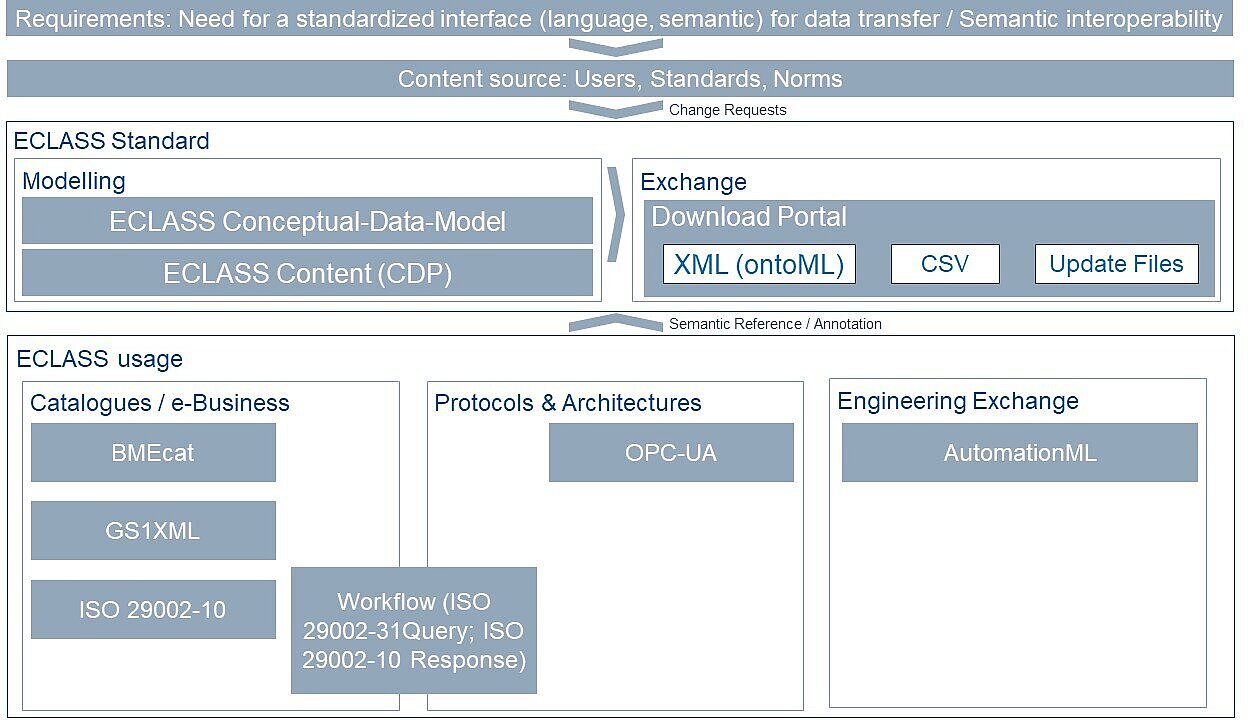ECLASS exchange and usage
Intro

There are a multitude of standards for product modeling, formats for exchange as well as protocols for transmission up to entire architectures, especially in the field of Smart Manufacturing. Current Standards Landscape for Smart Manufacturing Systems gives an overview of the variety and different fields of application with a special focus on digitization in the manufacturing context. ECLASS is a standard for product classification and product description and forms with the integrated semantics and product structure description the basis for the before mentioned approaches to data transmission.
Within ECLASS Standard there are different types of structural elements that are related Category:Structure and structural elements. This model is based on DIN 4002, IEC 61360 and ISO 13584 and is called the Conceptual Data Model. This model is used on the ContentDevelopmentPlatform CDP as the basis for generating product classification and product description. The different structural elements, are derived from norms, other standards as well as from the companies using ECLASS, which want to describe their products in a standardized way. Among other things, the instances of the structure element types map a class hierarchy and later serve as master for the product description. The following diagram summarizes the described facts, describes the exchange of ECLASS and shows the application of ECLASS in other standards.
ECLASS exchange
The dictionary must be made available in a suitable manner so that systems for data generation, data exchange and data interpretation can access ECLASS automatically. Several options are already available today for this purpose, which will be supplemented by further technologies in the future (compare Category:Products):
CSV
-
The basic representation of ECLASS is published as CSV and can be downloaded from the ECLASS Shop.
-
See Basic CSV and CSV file description
XML
-
The Basic & Advanced views on ECLASS are published as XML.
-
An XML file is available for each segment.
-
The XML representation of ECLASS is based on ontoML (ISO 13584-32).
-
The XML extraction can be downloaded from the ECLASS Shop
Furthermore, ECLASS offers so-called update files, which serve to update already created product descriptions (partially) autonomously to the new ECLASS version.
In development
As a further option besides the DownloadPortal a webservice is under development ECLASS Webservice This webservice will allow retrieval of structural elements in:
- XML (siehe oben)
- JSON (Currently a JSON representation of ECLASS is being worked on. With this it should be possible to access individual structural elements via REST access. This will later also serve as a new channel for creating change requests).
- RDF/OWL (Independent of the access, the association is currently working on an ECLASS representation in RDF/OWL).
Product data (exchange)
So far, only the ECLASS standard has been considered on its own. ECLASS is not an exchange format, but offers and describes elements that can be used for data exchange. This is basically done by means of a reference to the structural elements. This reference to the structural elements is made via the IRDI. This annotation by means of ECLASS makes the data points understandable with meaning and thus turns them into uniform, comprehensible information.
As already shown before, different levels can be considered in the product data life cycle. First of all, there is the dictionary, which defines necessary elements such as classes and characteristics. These structural elements can be provided with concrete values in catalog entries (items). However, this only describes a group of possible elements. Finally, concrete product instances (Thing) can also be described.
For an exchange of product models in the context of the respective life cycle phase are required suitable exchange formats or information models integrated in protocols and architectures. For this purpose, ECLASS has developed various integration concepts in cooperations in the last years in order to use ECLASS for data exchange by means of other standards and is constantly developing new ones: